Investing in Indian stock markets offers a plethora of opportunities for substantial returns if maneuvered wisely. Having said that, the complexity of the domain can be baffling. This article seeks to simplify two of the most crucial trading arenas in India – the Bombay Stock Exchange (BSE) and the National Stock Exchange (NSE). It’s imperative to know that trading is a technical process and depends on multiple factors including bse holidays 2024.
BSE Holidays 2024: Strategic Planning for Investors
One significant fact for the investors to know is the BSE holidays 2024. BSE holidays are the days when the trading sessions are not active. These include three categories of holidays, namely, National, Regional, and BSE specific holidays. By keeping a watchful eye on these holidays, investors can strategically plan their investments. Besides, the understanding of BSE holidays act as a useful tool to gauge potential impacts on the markets.
Understanding Commodity Futures and Their Trading Platforms
Similarly, knowledge of commodity futures is equally critical. Commodity futures are contract agreements to trade a specific commodity at a predetermined price and date in the future. Both BSE and NSE offer platforms for trading in commodity futures. This can range from agricultural products to precious metals and energy stocks. In 2021, INR 66 trillion worth of commodity futures contracts were traded at the NSE, and INR 32 trillion at the BSE.
Now, let’s delve deeper to further understand the key differences between BSE and NSE.
Trading Volume and Listings: Comparing NSE and BSE
Trading Volume: NSE, established in 1994, is the newest and the largest stock exchange in India on the basis of trading volume. The total trading volume at NSE in 2020 was around INR 4,58,58,47,344 whereas, BSE, being the oldest stock market in Asia established in 1875, had a trading volume of INR 2,07,00,48,290 for the same year. This indicates that NSE attracts a higher volume of trade.
Number of Listings: BSE has a larger number of listed companies. As of December 2021, more than 5400 companies are registered with BSE while NSE has about 1700 listed companies. However, due to higher trading volume and liquidity, most investors prefer NSE for large-cap stocks.
Indices, Derivatives Trading, and Global Presence: NSE vs. BSE
Indices: The benchmark index for NSE is NIFTY 50 which consists of the top 50 companies based on market capitalisation. For BSE, the benchmark index is SENSEX which is made up of the top 30 companies. As of January 2022, the NIFTY 50 market cap was INR 146 trillion and SENSEX was INR 91 trillion.
Derivatives Trading: Both exchanges provide platforms for derivatives trading, which includes futures and options. However, NSE has a more robust platform and a larger market share in derivative trading.
Global Presence: NSE has a broad global presence as it is listed in many international exchanges, and thus, it is preferred by foreign investors. BSE, on the other hand, has more of a domestic presence.
Conclusion
Remember, irrespective of the chosen platform for trading, either BSE or NSE, the essence lies in understanding the market trends, historical data, your financial goals, and risk-taking capability. Whether it’s staying updated with the BSE holidays 2024 or diving into the intricacies of commodity futures trading, knowledge, acumen, and alertness are vital.
Disclaimer: The information in this article is intended for informational and educational purposes only. It strongly encourages conducting your deep-dive research and/or consulting a financial advisor before making any investment decision. Keep in mind that investing in the stock market involves risk and potentially losing money.
